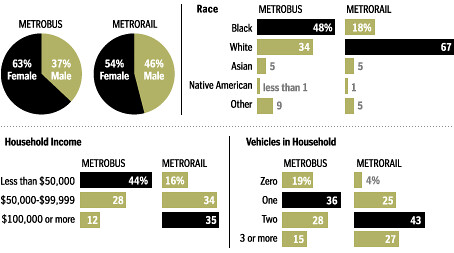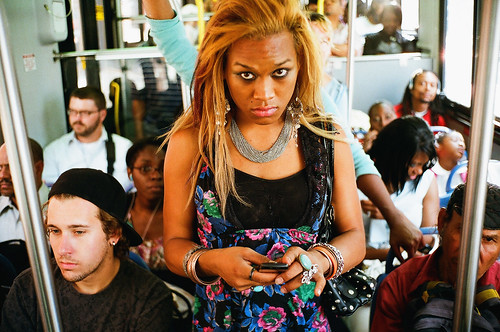Does transit really bring people together? Access vs. interaction/equity
A group in Detroit is mounting a crowdfunding campaign to develop pro-transit messages to help educate Metro Detroiters no longer familiar with the benefits of transit, because the car-centric region lacks a well-integrated transit system--the city and suburbs have separate bus systems, and many suburban cities don't participate.
-- 15 Minutes or Better: A Field Guide to Better Transit
But in a radio interview on Daily Detroit, Tom Choske of Freshwater Transit describes one of the benefits of transit as reducing inequality, not so much because of access, but by bringing people together from all economic strata. From the article:
Transit also has a key role to play ... to help with one of the hot-button issues in the country today, economic inequality. “One of the things that we’re really passionate about for transit, that we love about it, is that it really helps promote overall equity and equality. Transit is something that helps normalize the people who are wealthy and those people who are still struggling to get ahead,” said Choske. “By investing in public transit throughout the region, we can help bring people together and break down those barriers that have helped separate us so much.”I don't think that's the case. It's more like "separate worlds but equal access."
-- Definition of mobility access, University of Minnesota Accessibility Observatory
Passengers on a WMATA Metrorail car. Wikipedia photo.
When transit is present, we all have access to transit regardless of income and when we ride, we ride together.
However, the research shows that mode use correlates with income, so that the most expensive mode, railroad passenger service, tends to be used by the highest income users, and so it goes down the line, to urban and suburban bus transit, which tends to be used most by those with the lowest incomes.
But while people from different economic classes may travel together, I feel like our worlds are still separate.
 Transit rider demographics, Washington DC region. Washington Post graphic, 2005.
Transit rider demographics, Washington DC region. Washington Post graphic, 2005.That being said, there is no question that transit enables access to employment and schools and generally riding transit is cheaper than owning a car, and that this enables lower income people to better participate in the economy.
In fact, globally, the highest income metropolitan areas have the best transit systems and are significantly less dependent on the automobile.
At the same time, in the U.S. it is only the "wealthiest" communities that have or are developing high quality integrated transit systems (various forms of rail and bus transit), with a land use development paradigm that prioritizes transit as the primary means of mobility simultaneously enabling density and the inclusion of high quality amenities. (Although it isn't always the case that legacy cities and their transit systems, such as Philadelphia, have been able to maintain their economic position vis-a-vis their suburbs.)
 Riding the X2 Metrobus in DC. Flickr photo by Matt Dunn.
Riding the X2 Metrobus in DC. Flickr photo by Matt Dunn.And this leads to higher valuation of places proximate to transit, which tends to displace those of lesser means ("Group calls for more low-income housing," Washington Post; "Maintaining Diversity inAmerica’s Transit-Rich Neighborhoods:Tools for Equitable Neighborhood Change," Federal Reserve Bank of Boston), to the point where low income advocates often find themselves taking anti-transit positions out of a belief that fixed rail transit in particular is a displacement tool (see "Garcia, champion of working class? He should
overhaul transportation platform," Crain's Chicago Business) and that transit only serves the wealthy.
The rise in interest in what is called "transportation equity" aims to address this problem.
-- Transportation Equity Network
-- Transportation Equity Caucus
Labels: equity planning, transit and economic development, transit marketing, transportation equity, urban design/placemaking, urban revitalization




7 Comments:
I'm not sure this is true.
For DC, yes, but heavily skewed by the federal transit benefit and that Metrobus is mostly DC+PG county.
Not so sure if we can draw an easy line between wealth and transit+land use.
From your study quoted:
"These data tend to show that while cities may reach the ®nancial capacity for high levels of car ownership, the actual need to use the cars diers greatly. For example, the data suggest that US cities may be building in more compulsory car use than other cities through very auto-dependent land use patterns and a general lack of viability of other modes because travel distances are long and activities are not concentrated enough for eective transit or non-motorised modes (see later). In addition, the hostile public realm of many parts of US cities can discourage people from using modes that expose them to threatening physical and social elements (Garreau, 1991; Calthorpe, 1993; Kunstler, 1993; Kenworthy and Newman, 1993)."
We know who the hostile public realms were in 1993.
If we look in DC, the "Wealth" isn't just land value.
I remember reading "nature's end" in high school, crazy ass book, but made the point that in the future the LA transit system was kept open to the door (and was awful) while the NYC city one was for the ultra rich and beautiful.
I get a little queasy about some of the pop-psych that urbanists sometimes propose (because it "feels right"). Generally the psychological studies on proximity and people show that while we actually do a preference for diversity at the regional scale: we prefer homogeneity at local scale. At least in the aggregate. Transit might actually do the opposite by breaking down those carefully constructed bubbles of sameness. Seems pretty low either way as a reason to pitch transit. It's the same thing with studies about "social capital" which is not really well understood nor sourced. Building together does improve our relationships with each other but can that be measured in a scientific way? Probably not.
I've been meaning to write about an interesting presentation at a conference held by Casey Trees which linked social capital to environmental issues at the neighborhood scale.
and another piece I read (which explains why I have such a small following) about how when you talk about bad things, feelings of economic pressure, etc., people don't get a sense that they have the economic wherewithal to address problems with the aim of changing things for the better. Instead they just throw in the towel.
... so when talking about some of these issues with Suzanne yesterday morning, it occurred to me that in DC we don't have the same level of anti-government anti-tax sentiment that we see in other places, at least judging by the comments on newspaper articles (I like to read them to get a sense of the tenor of the times).
2. at the APA conference in DC I think in 2004, I went to a pre-conference workshop by a national neighborhood assn. where they were pushing the "community efficacy" model (Harley Earls). We weren't into it. In theory I want to believe that communities with more "community" work better. The problem that economically challenged communities have even with greater efficacy is that in itself it's not enough to make those neighborhoods better compared to equivalent neighborhoods with less sense of community.
(cf. Klinenberg's arguments post Superstorm Sandy, but also his work on Chicago and heat--wave related deaths.)
This gets back to the piece yesterday about better defining a neighborhood community building agenda and assisting its implementation (comparable to the piece where I outlined what I consider to be the ideal ward-focused councilmember agenda-platform).
_Nature's End_ sounds like a book I need to read.
Good point about Metrobus operational areas skewing its demographics. It would be interesting to do similar studies of the other systems in the area. RideOn is probably mixed. In the Rockville Pike corridor it is probably more white, more high income, as the system service footprint was designed to get people from their house to Metrorail without driving. In East County, which is much more heavily minority and since it abuts where I live, I am more likely to ride RideOn buses in this area, which skews my perception of demographics, ridership is predominately minority.
It would be interesting to see how this breaks down in Alexandria, Arlington, and Fairfax.
oh, the study I quoted was old, and I used it because it was downloadable. Newman and Kenworthy continue to research in this area, and the findings generally support their thesis about transit richness and metropolitan-scale income and wealth.
e.g., there looks to be a very interesting chapter co-authored by Newman in the new _Routledge International Handbook on Sustainable Development_ on transportation and land use. That's 2015...
Christopher is a on a roll and articulated my concerns far better and in a more pleasant way.
I do think a lot of this is about economic class. But perhaps I overgeneralize from my block.
On one side of our house lives an Af-Am household of lifelong Washingtonians, who've lived here for 30+ years, their three kids are very successful. On the other side is a Hispanic household (one from Brazil the other from El Salvador) with two "American" kids. The block is mostly African-American but every example of housing turnover is of whites or Hispanics or mixed couples of various sorts.
People get along fine. But I think it's because we're all the same class.
I can't claim to be super comfortable interacting with lower income households elsewhere in the city.
Post a Comment
<< Home